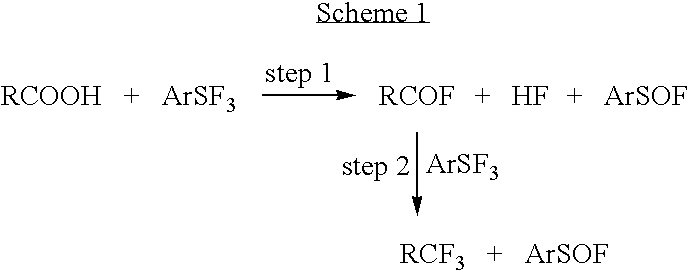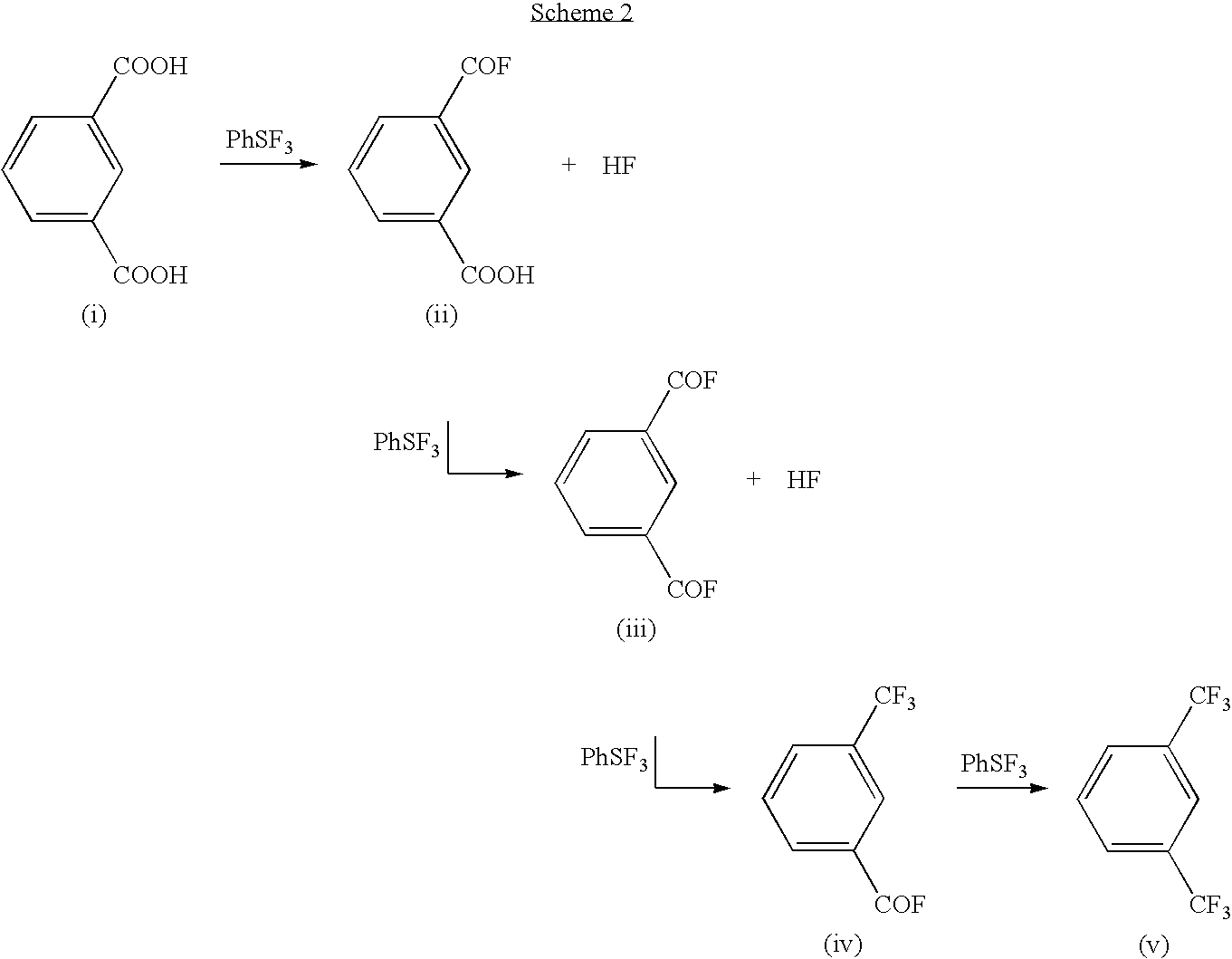Methods and compositions for producing difluoromethylene-and trifluoromethyl-containing compounds
a technology of trifluoromethyl and difluoromethylene, which is applied in the field of difluoromethyleneand trifluoromethylcontaining compounds, can solve the problems of difficult and expensive synthesis, significant drawbacks of conventional methods, and impede the use of cf/sub>2/sub>, and achieves the effect of convenient preparation or convenient preparation
- Summary
- Abstract
- Description
- Claims
- Application Information
AI Technical Summary
Benefits of technology
Problems solved by technology
Method used
Image
Examples
example 1
Production of Difluoromethylene-Containing Compounds
[0106]
[0107]The reaction of Example 1 was performed in dry atmosphere under nitrogen. A solution of 2-phenyl-1,3-dithiane (85 mg, 0.47 mmol) in 1 mL of dry methylene chloride was dropwise added to a solution of phenylsulfur trifluoride (200 mg, 1.2 mmol) in 1 mL of dry methylene chloride. The reaction was performed in a fluoropolymer (PFA) reactor. The reaction mixture was stirred at room temperature for 2 hours. The reaction mixture was analyzed by 19F-NMR, showing that (difluoromethyl)benzene was produced in 99% yield. The product was identified by comparison with an authentic sample. 19F NMR (CDCl3 as a solvent; CFCl3 as a standard) for PhCF2H: −110.5 ppm (d, J=56 Hz, CF2).
examples 2-8
Production of Difluoromethylene-Containing Compounds
[0108]Examples 2-8 were conducted under conditions as shown in Table 3 in a similar manner as for Example 1. The results are shown in Table 3 together with Example 1. The products were identified by spectral analyses and / or by comparison with authentic samples. 19F NMR data (ppm; CDCl3 as a solvent; CFCl3 as a standard) of the products are shown in Table 3.
TABLE 3Preparation of Various Difluoromethylene-containing Compounds with ArSF3and R1—C(R3)(R4)—R2.Product,19FArSF3R1—C(R3)(R4)—R2SolventTempTimeR1CF2R2Yield*NMREx. 1PhSF3 (1.2 mmol)CH2Cl2 (1 mL)r.t.2 hPhCF2H94%−110.5 (d, J = 56 Hz)Ex. 2p- CH3C6H4SF3 (1.3 mmol)CH2Cl2 (1 mL)r.t.2 hPhCF2H95%−110.5 (d, J = 56 Hz)Ex. 3PhSF3PhC(═S)PhCH2Cl2r.t.2 hPhCF2Phquant−88.7 (s)(4.10 mmol)(1.64 mmol)(1 mL)Ex. 4PhSF3PhC(═S)OCH3CH2Cl2r.t.3 hPhCF2OCH398%−72.2 (s)(3.45 mmol)(1.39 mmol)(1 mL)Ex. 5PhSF3n-CH2Cl2r.t.20 h n-80%−77.8 (s)(2.55 mmol)C7H15C(═S)OCH3(3 mL)C7H15CF2OCH3(1.66 mmol)Ex. 6PhSF3 (2.85...
example 9
Production of Trifluoromethyl-Containing Compounds
[0111]
PhC(═S)SCH3+PhSF3→PhCF3
[0112]This reaction was performed in anhydrous atmosphere under nitrogen. Phenylsulfur trifluoride (264 mg, 1.59 mmol) and methyl dithiobenzoate (53.5 mg, 0.31 mmol) were put in a fluoropolymer (PFA) tube (reactor) at room temperature, and then the tube was sealed. The reaction mixture was heated at 70° C. for 22 hours. The reaction was then cooled to room temperature and analyzed by 19F-NMR. The analysis showed that benzotrifluoride was produced at 85% yield. The product was identified by comparison with an authentic sample. 19F NMR for PhCF3 (CDCl3); −62.6 ppm (s, CF3).
PUM
| Property | Measurement | Unit |
|---|---|---|
| boiling point | aaaaa | aaaaa |
| organic | aaaaa | aaaaa |
| molar ratio | aaaaa | aaaaa |
Abstract
Description
Claims
Application Information
 Login to View More
Login to View More - R&D
- Intellectual Property
- Life Sciences
- Materials
- Tech Scout
- Unparalleled Data Quality
- Higher Quality Content
- 60% Fewer Hallucinations
Browse by: Latest US Patents, China's latest patents, Technical Efficacy Thesaurus, Application Domain, Technology Topic, Popular Technical Reports.
© 2025 PatSnap. All rights reserved.Legal|Privacy policy|Modern Slavery Act Transparency Statement|Sitemap|About US| Contact US: help@patsnap.com



